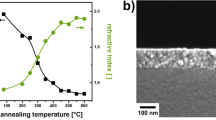Abstract
Precursor solutions for zirconia films on soda lime silica glass substrate were prepared from zirconium oxychloride octahydrate (ZOO) and acetic acid (HOAC) maintaining the mol ratios, [HOAC]/[ZOO]=2, 4, 6, 8 and 10. A characteristic UV absorption band at ∼280 nm in the ∼120h aged precursor solutions was identified for acetate group of the zirconium acetato complexed species. The presence of acetate ligand coordinated with either ZrOOH+ or [Zr4(OH)8]8+ or with both was predicted by the studies of UV spectra of aged solutions and FTIR spectra of unbaked films on silicon wafer. Dipping technique was followed for film formation. Thicknesses and refractive indices of the baked (450°±5°C) films were in the ranges 1818±20 Å and 1.702–1.762 respectively. The positive SIMS experiment on two typical films baked at 450°±5°C derived from the precursors with [HOAC]/[ZOO]=2 and 6, detected the ionic species, Zr+, ZrO+, ZrO +2 , Na+, Ca+, Fe+, H+ while the negative SIMS detected O− and Cl−. The relative contents of the ionic species with respect to Zr+ were dependent on the acid content of the precursors. Reflection (%) of the baked films in the UV region was also dependent on the acid content of the precursors. Electron diffraction pattern of the typical baked film derived from the precursor with [HOAC]/[ZOO]=2 exhibited meta-stable cubic phase of zirconia and the grains were found to be elongated (aspect ratio, 2.00–2.33).
Similar content being viewed by others
References
W.J. Coleman, Appl. Opt.13, 946 (1974).
H.K. Pulker, Appl. Opt.18, 1969 (1979).
H.K. Pulker, Thin Solid Films34, 343 (1976).
H. Schroeder, inPhysics of Thin Films: Advances in Research and Development, edited by G. Hass and R.E. Thun (Academic Press, New York, 1969), Vol. 5, p. 87.
A.K. Atta, P.K. Biswas, and D. Ganguli, Thin Solid Films197, 187 (1991).
W.W. Davison and R.C. Buchanan, inCeramic Substrates and Packages for Electronic Applications: Advances in Ceramics, edited by M.F. Yan, K. Niwa, H.M. O'Bryan, Jr., and W.S. Young (The American Ceramic Society, Inc., Ohio, 1987), Vol. 26, p. 513.
J.-L. Tosan, B. Durand, M. Roubin, F. Chassagneux, and F. Bertin, J. Non-Cryst. Solids168, 23 (1994).
K. Izumi, H. Tanaka, M. Murakami, T. Deguchi, A. Morita, N. Tohge, and T. Minami, J. Non-Cryst. Solids121, 344 (1990).
W.B. Blumenthal,The Chemical Behaviour of Zirconium (D. Van Nostrand Co., Inc, New Jersey, 1958), pp. 128, 162, 163, 312, 316.
A.K. Atta, P.K. Biswas, and D. Ganguli, J. Non-Cryst. Solids125, 202 (1990).
C.N.R. Rao,Ultraviolet and Visible Spectroscopy (Butterworth & Co., London, 1975), pp. 36, 130.
I.L. Finar,Organic Chemistry (Longmans, Green & Co., London, 1954), Vol. 1, p. 153; (1973), p. 248.
F.A. Cotton and G. Wilkinson,Advanced Inorganic Chemistry, 3rd edition (Willey Eastern Ltd., New Delhi, 1972), pp. 812, 930.
J. Muhlebach, K. Muller, and G. Schwargenbach, Inorg. Chem.9, 2381 (1970).
S. Komarneni, R. Roy, and E. Breval, J. Am. Ceram. Soc.68, c-41 (1985).
M. Chatterjee, M.K. Naskar, and D. Ganguli, Trans. Ind. Ceram. Soc.52, 51 (1993).
J.P. Walter and M.Y. Dartiguenave, J. Inorg. Nucl. Chem.35, 3207 (1973).
F. Pancrazi, J. Phalippou, F. Sorrentino, and J. Zarzycki, J. Non-Cryst. Solids63, 81 (1984).
G.L. Miller, inMetallurgy of the Rarer Metals-2: Zirconium, edited by H.M. Finniston (Butterworths Scientific Publications, London, 1957), p. 176.
K.K. King, B. Atwood, and P. Byard, inChemical Processing of Advanced Materials: Importance of Sol-Gels to Modern Large Telescopes, edited by L.L. Hench and J.K. West (John Wiley & Sons, Inc., New York, 1992), p. 435.
A. Duparre, E. Welsch, H.-G. Walther, N. Kaiser, H. Muller, J. Meyer, and P. Weissbrodt, Thin Solid Films187, 275 (1990).
Author information
Authors and Affiliations
Rights and permissions
About this article
Cite this article
Jana, S., Biswas, P.K. Chemical behaviour of zirconium oxychloride octahydrate and acetic acid in precursor solution for zirconia film formation on glass. J Sol-Gel Sci Technol 9, 227–237 (1997). https://doi.org/10.1007/BF02437186
Received:
Accepted:
Issue Date:
DOI: https://doi.org/10.1007/BF02437186




